8/1/2018
Spinning the Herb Wheel
Christopher J. Currey & Thabisa Z. Mazur
Consumers are having an increased interest in food. Whether it’s local, organic, sustainable or simply fresh, the awareness of and attitudes of consumers toward food is changing.
As part of this trend, containerized herbs are increasing in popularity. When setting out to choose what to grow, the number of cultivars and selections available can be dizzying. However, with the large variety of genetics comes the opportunity to find the right selection for your needs.
Flavor
The first and primary determinant of what you’re going to select and grow is based on flavor. After all, their culinary use for flavoring food is why herbs are so popular. When you’re selecting different herbs to grow, be sure to grow an assortment. Although basil is the most popular culinary herb, you’ll want to produce other species that will complement basil production and result in a diversified mix of culinary herbs.
There’s more to selecting cultivars than different genera of herbs. For some herbs, different species, though closely related, may have different flavors.
Let’s take a look at basil (Ocimum sp.). When you hear “basil,” the sweet basil (O. basilicum) used for making pesto and other Italian food is likely the first one to come to mind. However, there are other basils with different flavor profiles, such as citrus-flavored lemon basil (O. americanum) or the spicier-flavored holy basil (O. tenuiflorum), to name a few.
Oregano (Origanum sp.) is another example of an herb with variations in flavor; there’s the classic Italian oregano (O. x majoricum), but there’s also the spicier Greek oregano (O. vulgare var. hirtum).
While some similarly named herbs may have different flavors, there are also some herbs that have a flavor similar to one species, but are unrelated. For example, take a look at tarragon: French tarragon (Artemisia dracunculus) is the standard for this herb. However, Russian tarragon (Artemisia dracunculoides) is a closely related species that can provide similar aroma and flavor, but is easier to cultivate than French tarragon. There’s even a third species, Mexican tarragon (Tagetes lucida), that has similar flavor, but grows well in hot, dry conditions.
Cilantro is another example. Cilantro (Coriandrum sativum) is a popular herb for its fresh flavor, but can be sensitive to warm temperatures; the foliage of Mexican coriander or culantro (Eryngium foetidum) has a similar flavor, but is more tolerant of warmer and drier conditions.
Size
For growing plants in containers, size does matter. We want to produce plants that are balanced with the container size they’re grown in. Depending on the species you’re interested in growing, there may be a range of cultivars that vary in size, whether it’s variation in the size of the whole plant or simply the leaves.
Your selection will vary with the int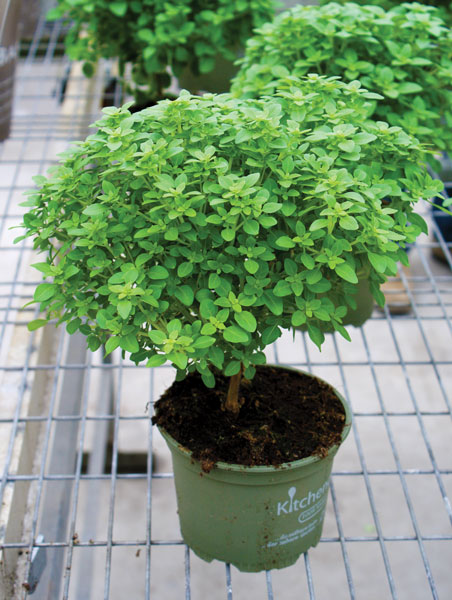 ended use of the plant. First, there are compact or dwarf varieties that are smaller than traditional cultivars. For example, Fernleaf dill (Anethum graveolens) is a cultivar that grows to approximately one-half the height of traditional dill cultivars. Similarly, there are several compact varieties of basil that are smaller than standard green sweet basil cultivars. While these dwarf cultivars may not be exactly what consumers may desire for the garden, they’re very well-suited for containerized production, as they’re more proportional to the containers they’re being grown in.
ended use of the plant. First, there are compact or dwarf varieties that are smaller than traditional cultivars. For example, Fernleaf dill (Anethum graveolens) is a cultivar that grows to approximately one-half the height of traditional dill cultivars. Similarly, there are several compact varieties of basil that are smaller than standard green sweet basil cultivars. While these dwarf cultivars may not be exactly what consumers may desire for the garden, they’re very well-suited for containerized production, as they’re more proportional to the containers they’re being grown in.
Aside from simply the size of plants, cultivars of some species will have very large or, alternatively, small foliage. For example, Lettuce-leaf sweet basil has leaves that are several-times larger than standard sweet basil foliage, lending themselves useful for specialized culinary presentations. There are also some basil cultivars with extremely small or fine leaves. While found on some of the dwarf or compact basil varieties, their small leaves are also useful for producing appealing grafted basil topiaries (Figure 1).
Figure 1. Grafted basil plants are the result of a standard sweet basil rootstock and stem with a scion from a fine-leaved bush basil cultivar grafted to it.
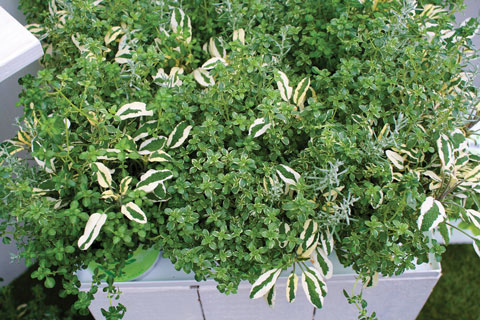 Foliage
Foliage
In addition to the size of finished plant materials, the appearance of foliage is also something to take into consideration when selecting your containerized herb cultivars. Variegation is one of the most common foliage appearances that can increase interest in your products. There are a number of herbs that have variegated varieties (Figure 2), including some cultivars of sage (Salvia officinalis) and thyme (Thymus vulgaris).
Figure 2. Variegated leaves can enhance the ornamental appeal of some herbs, like this sage cultivar.
In addition to variegation, some cultivars have foliage that’s an entirely different color than the standard species. For instance, there are purple-leaved varieties of sweet basil, fennel (Foeniculum vulgare) and sage. (One note about these purple-leaved varieties is that they tend to be slower-growing than their green-leaved counterparts; be sure to allow for some extra bench time for these cultivars.)
Propagation method
The propagation method for specific cultivars may influence your selection. The vast majority of containerized herbs are propagated with seeds (sexual) or cuttings (vegetative or asexual).
One of the benefits of using seed for production is that, due to the relatively inexpensive cost for herb seed, it can be affordable to sow multiple seeds per plug and produce more dense finished plants in a shorter amount of time than single-seed sown plugs. However, there are some varieties that are only propagated vegetatively and don’t come true from seed. Look to see what vegetatively propagated cultivars are protected by a patent. For those varieties that aren’t protected, there may be opportunities for you to produce your own cuttings. For those varieties that are protected, be sure to procure cuttings lawfully in-house or from an outside source.
Temperature tolerance
We also need to consider the environment in which containerized herbs will be grown and sold. In some regions, production problems can arise when temperatures get too warm. For some herbs, premature flowering or bolting can be problematic when it’s warm. If you’re trying to produce year-round, look for heat-tolerant cultivars of normally sensitive varieties for summer production when the greenhouse is hot. For example, Calypso cilantro is a more heat-tolerant variety that won’t prematurely flower or bolt under warmer temperatures compared to traditional cilantro cultivars.
Disease resistance
One of the challenges in producing edible plants like herbs is diseases can be a greater challenge to control due to the lack of labeled fungicides. Some varieties were selected, either in part or entirely, for their resistance to diseases. For example, Nufar and Aroma 2 are basil cultivars with resistance to Fusarium wilt, while Eleonora sweet basil has intermediate resistance to basil downy mildew. These resistances to diseases will not only benefit you as a grower, but may also allow your customers to be more successful when they bring plants home.
Take-home message
Containerized herb production is an area where most producers have an opportunity to expand what’s grown and their product portfolio. However, before anything is planted, carefully look at what genetics are available to grow. Whether it’s unique flavors, appearances or other desirable attributes, the large selection of cultivars provides the opportunity to select cultivars that will fill your need.
We’ve included a table (Table 1) summarizing the characteristic of culinary herb cultivars; while this is by no means a comprehensive list, it should be a good place to start familiarizing yourself with the options that are available. GT
Table 1. A summary of notable characteristics for cultivars of popular culinary herb species.
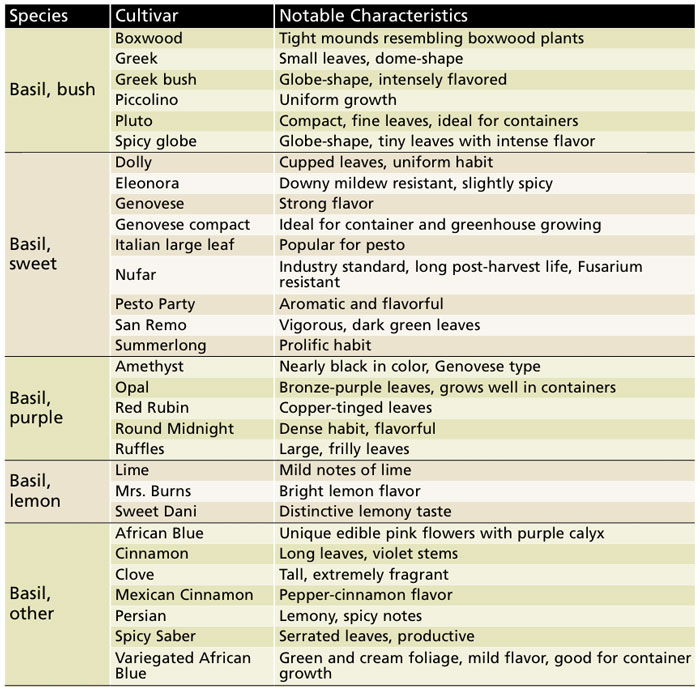
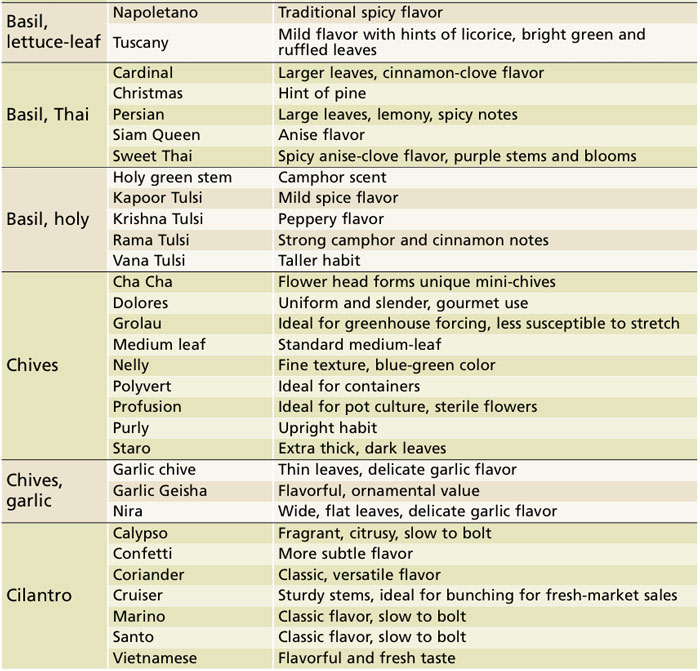
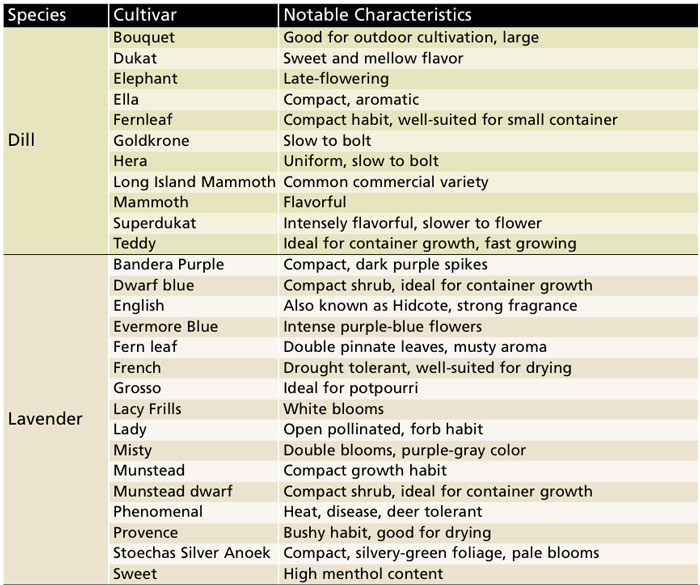
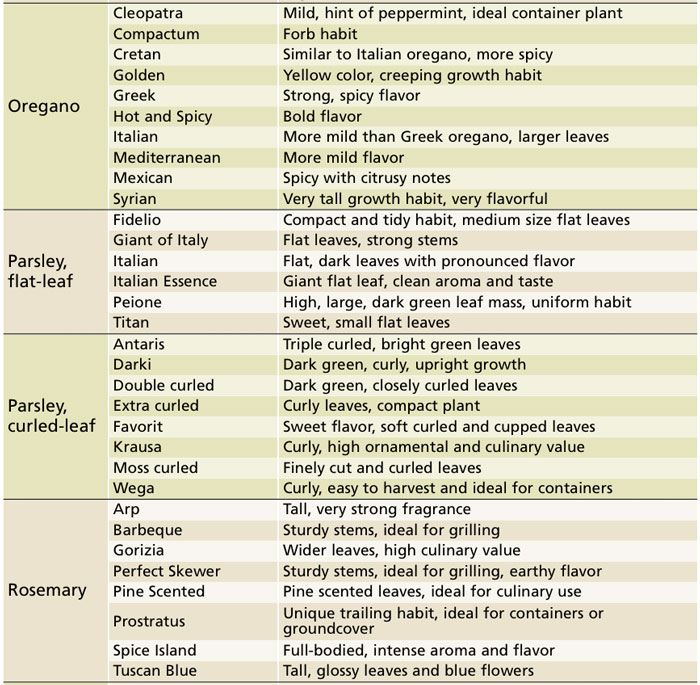

Christopher J. Currey (ccurrey@iastate.edu) is an assistant professor and Thabisa Z. Mazur is an undergraduate research assistant in the Department of Horticulture at Iowa State University.